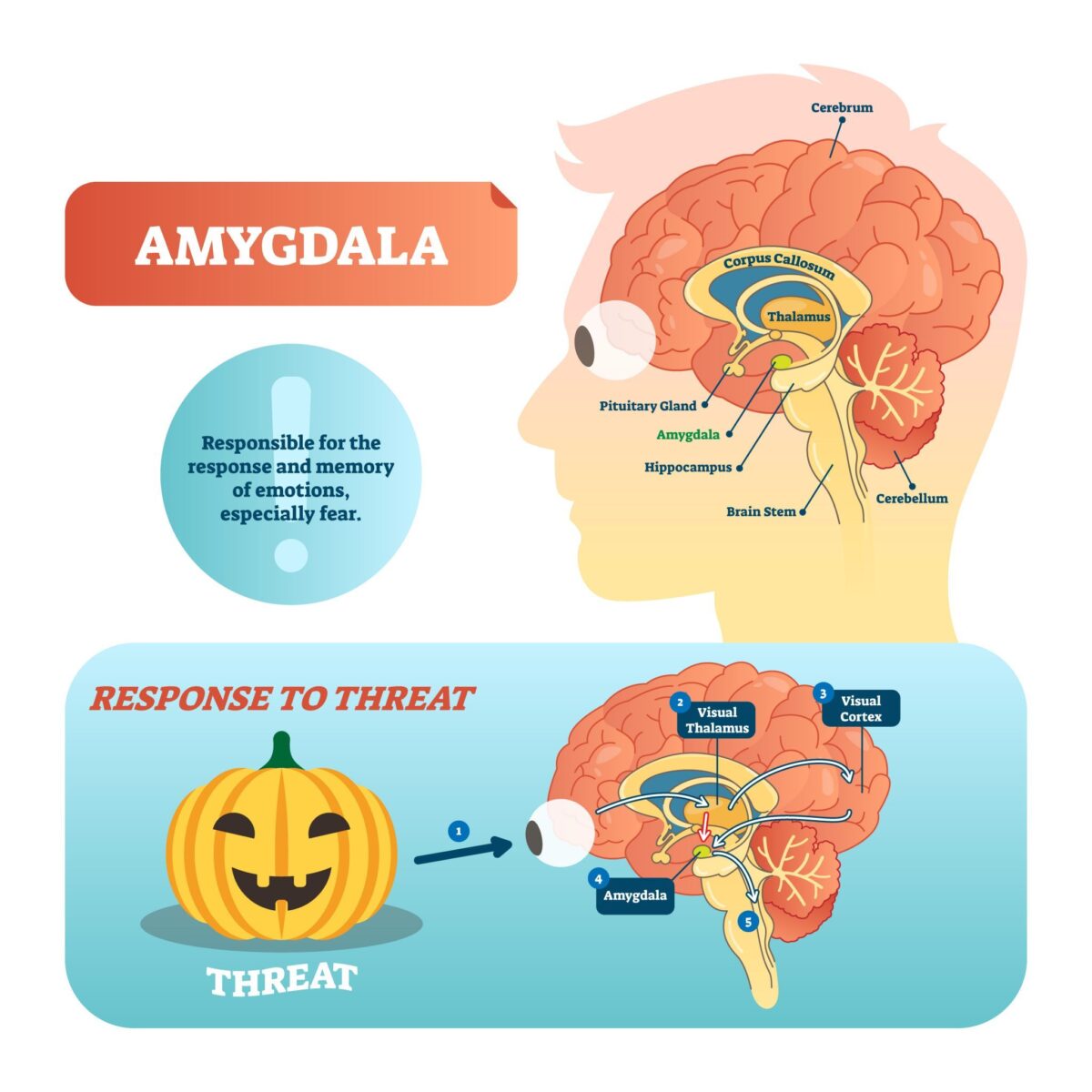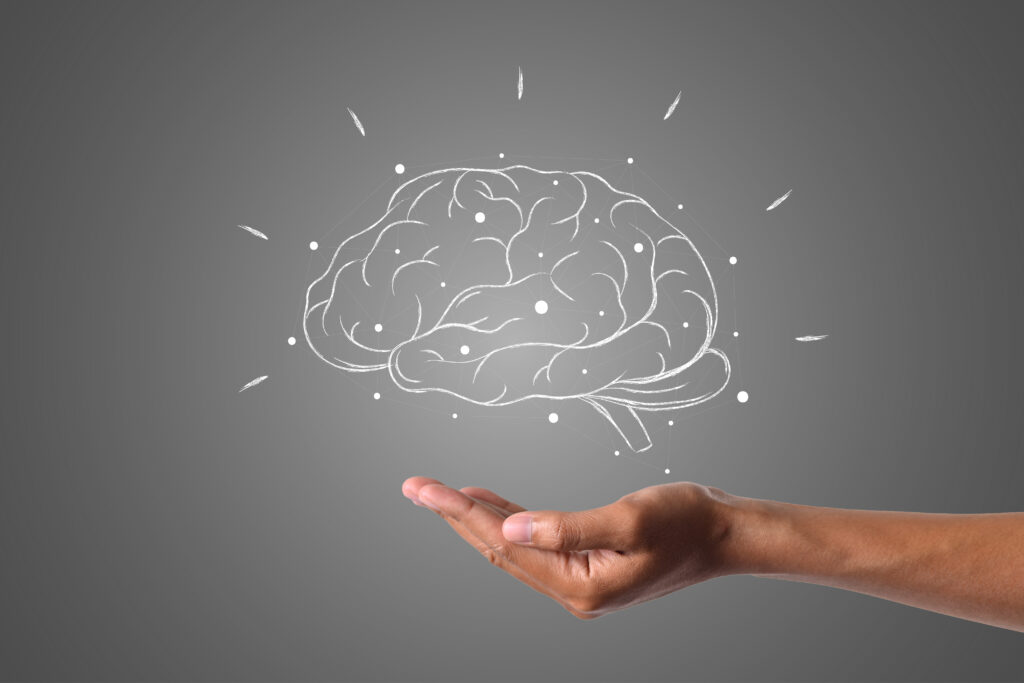
Amygdala: The powerhouse of emotions
Our brain is a palace of structures. It dictates everything we do, how we think, how we behave and how we feel. In this article, we will focus only on the amygdala (sounds like a character out of a Star Wars movie): From what it is, functions, neurophysiological aspects of the amygdala, what happens if it gets damaged, and its relationship with other brain areas.

What is the amygdala?
The amygdala is a structure in the limbic system that is involved directly with motivation: Particularly related to survival and our emotions. It is also responsible for processing emotions such as fear, pleasure, and anger.
The amygdala is the house where all of our emotions are stored. One of its main functions is to help us to recognize potential threats when we encounter them. When doing this, it revs the body up in preparation for a fight or flight response by increasing our breathing and heart rates. It is also responsible for evaluating the emotional intensity of various situations. This is especially important because since we encounter certain situations repeatedly, from emotional memory, our amygdala wouldn’t need to fire up… unless our brains say otherwise.
The word ‘amygdala’ was derived from the Greek word for “almond” since this part of our brain is shaped like one. Like most other structures in our brain and in other animals, we have two amygdalae. Each amygdala is located on each of the left and right temporal lobe. Since it’s in very close proximity to the hippocampus, the amygdala is involved with the influence of memory consolidation. Memory consolidation is the process that stabilizes a memory trace right when it has been obtained.
Amygdala: The limbic system
To understand the amygdala a little bit better, this article is going to give a swift review of the limbic system and why it’s important.
The limbic system is not a separate system, but a system composed of several key structures in the brain including the diencephalon, mesencephalon, and telencephalon. The limbic system specifically includes the amygdala, thalamus, hippocampus, hypothalamus, basal ganglia, and cingulate gyrus.
You can find the limbic system nuzzled immediately underneath the cerebrum. The limbic system is important because it is responsible for the formation of memories, and our emotional lives are stored in this area of the brain. The components of the limbic system regulate endocrine and autonomic function in response to any sort of emotional stimuli. In short, the three key functions it is known to deal with are arousal (stimulation), memory, and emotions.
Hemispherical differences
Since we possess two amygdalae, it has been noted that the left and right amygdala serve a different purpose in how we process our emotions. Even though the left and right amygdala have independent memory systems, they still work as a team to encode, store and interpret our emotions.
Studies have reported that electrical stimulations to the right amygdala provoke negative emotions of sadness and fear. When looking at the left side, electrical stimulations induce unpleasant (anxiety, sadness, and fear) feelings, yet also has the ability to induce positive emotions such as happiness.
The right hemisphere is commonly associated with declarative memory. Declarative memory stores various information and facts from previously experienced events which need to be consciously recalled. The right amygdala is also responsible for the retention of episodic memory. Episodic memory stores the autobiographical memory, which allows you to recall sensory and emotional experiences of a particular event.
Development of the amygdala
The development of the amygdalae is an interesting tale that consists of developmental differences between the right and left amygdala, as well as sex differences.
When looking at this area of the brain, there are some observable differences in the growth of the amygdalae. The left is the first to develop, reaching its peak 1.5-2 years before the right. Looking aside from the early growth of the left, the right has a continuous increase in volume for a longer period of time. The right side of the amygdala is often associated with face recognition and fear stimuli. As for the left, it is said that its early development provides infants with the capability of being able to detect danger.
There are also considerable differences in the development of the amygdalae between male and females. In the early stages of development of the brain, it is seen that the limbic system in females grows much more quickly than in males. For males, the structural development of the amygdalae occurs over a longer period of time, while females reach their full growth potential 1.5 years before their counterparts. It is noted that reasoning behind the slower development of the male amygdalae is due to relatively larger sizing.
Sex distinction
In regards to the differences in sexes, this area of the brain is one of the best understood. As briefly described above, we see that the amygdala is larger in male adults and in adult rats.
Adding to size, the functioning of the amygdalae differs in males and females. In one study, participants amygdala activation was looked at by watching a horror movie. Results of this study showed a completely different lateralization in the amygdalae between males and females. They showed that enhanced memory of the film was related to more activity occurring in the left amygdala and not the right. For males, it showed that the memory of the film was related to the right and not the left.
The left is responsible for the recollection of details, which results in more thought than action in response to emotionally stressful stimuli. This can be used to attribute why we see less of a physical response in women than in men. The right has been linked to taking action and has been linked to negative emotions. In this scenario, this is why we see males respond to emotionally stressful stimuli in a physical manner.
Functions of the amygdala
- Memory – This area of our brain has been linked to the storage of our emotional memory. The amygdala is heavily involved in calculating the emotional significance of events that occur in our lives. Since the amygdala has connections to other regions of the brain, it also has an influence on emotional perception. What this means, is that the amygdala alerts us to notice significant events even when we are not paying attention.
- Arousal – Sexual desire is largely mediated by the limbic system. Activation of our amygdala can cause sexual feelings, memories of sexual intercourse, penile erections, orgasms, uterine contractions, and ovulation.
- Hormonal secretions – When experiencing stressful events, our amygdala sounds the alarm by sending a distress signal to our hypothalamus. When this happens, the hypothalamus activates the SNS (sympathetic nervous system) by sending signals through autonomic nerves to the adrenal glands. Then, the glands will respond by pumping out epinephrine, also known as adrenaline. The amygdala is also strongly modulated by serotonin, norepinephrine, epinephrine, and dopamine.
What happens if the amygdala is damaged?
Because there are two amygdalae, if there is a bilateral lesion, there is a reduction in aggression and fear. This may mean you may adopt a superman complex and feel like nothing can hurt you or scare you… unless it’s kryptonite. A study was done on monkeys who had bilateral lesions of their amygdala and researchers reported a huge drop in fear and aggression, just as we see in our human counterparts.
Don’t hold your breath there though. Even though the monkeys showed a significant drop in fear and aggression, humans are faced with a lot more when the amygdala is destroyed. A bilateral lesion can cause an individual to have an impaired ability to interpret emotional facial expression. Kind of sounds like Autism. This type of lesion has actually been linked to autism, with MRI scans detecting an increase in amygdala volume.
Neuropsychological correlates of the amygdala
Advancements in neuroimaging technology have made it possible for neuroscientists to make significant findings related it. Data has shown that the size of an individual’s amygdala can be linked to anxiety, and how size may fluctuate due to antidepressant medication consumption (left). Certain studies have also shown children with anxiety tend to have smaller amygdalae.
Aside from those two interesting facts, data has shown that the amygdala plays a large role in particular mental disorders as well as other mental states.
Fear
A very rare genetic disease known as Urbach-Wiethe disease is responsible for focal bilateral lesions of the amygdala in people. Such a disease results in individual’s showing no signs of fear. This finding of the disease continues to prove that the amygdala plays a large role in triggering the state of fear.
Aggression
Several studies that have looked at animals have repeatedly shown that stimulating the amygdala induces sexual and aggressive behavior.
Schizophrenia
Schizophrenic patients are known to have enlarged ventricles, as well as enlarged amygdalae.
Social interaction
It has been said that there is a positive correlation between amygdala volume and the size and complexity of social networks. Size, in this case, means the number of contacts an individual may have, while complexity stands for the number of different groups an individual belongs to.
Data reveals that the larger a person’s amygdalae are the larger amount of social networks an individual has.
It has also been shown that the amygdalae are responsible for processing the violations of personal space. It has been observed in fMRI scans that this region of our brain is activated when it is sensed that a person is standing very close to them. For example, the person who is being scanned is aware when the observer is physically close to them, then when the observer is standing at a distance.
Sexual orientation
In recent studies, it has been suggested that there may be possible correlations between connection patterns in the amygdala, and sexual orientation. It has been reported that homosexual males have a tendency to show more feminine patterns in the amygdala than heterosexual males do. Homosexual females tended to show more masculine patterns in the amygdala than heterosexual females.
Bipolar Disorder
It is well documented that in bipolar disorder, there is great amygdala dysfunction during facial emotion processing. Those who have bipolar disorder have also displayed increased activity in their amygdala.
Post-Traumatic Stress Disorder (PTSD)
Patients who suffer from PTSD typically have a hyperactive amygdala in response to various stimuli that are in some way connected to trauma.
Depression
It is also overactive in those who suffer from depression, especially when you present them with sad stimuli. However, when presented with “happy” stimuli, their amygdala is under-active.
Anxiety
It is responsible for setting off a chain reaction for this disorder. It begins to react because some environmental stressor has convinced this area of the brain that you are in danger. However, this is only an issue to worry about when the amygdala is regularly triggered.
Amygdala and other brain regions
It holds some very special connections with other areas of the brain. It is known to make reciprocal connections with the hypothalamus, thalamus, septal nuclei, hippocampus, parahippocampal gyrus, orbital frontal cortex, the brain stem, and the cingulate gyrus.
The amygdala receives input from all senses as well as visceral inputs. Visceral inputs derive from the hypothalamus, parabrachial nucleus, septal area, and orbital cortex. Visual, auditory, and somatosensory information comes through via the temporal and anterior cingulate cortices. Olfactory sensory information is received from the olfactory bulb.
Some output pathways of the amygdala include:
- Stria terminals
- Ventral amygdalofugal pathway
- Directly to the hippocampus
- Directly to the dorsomedial nucleus of the thalamus
- Directly to the entorhinal cortex
Amygdala/emotional hijacking
Emotional hijacking is an event that occurs when an individual’s cognitions are overpowered by their emotions. You normally see emotional hijacking occur in the context of fear and aggression. A perfect example of emotional hijacking to kick off this section is when Mike Tyson bit Evander Holyfield’s ear. According to Daniel Goleman who coined the term amygdala hijacking, this bad decision on Tyson’s behalf is the perfect example of it.
The neocortex – the “thinking” brain, has been completely overridden, and the amygdala fires up taking over total control of the brain; Thus the name “amygdala hijacking.” Hijacking can cause a person to perform irrationally, making decisions that are destructive. Not only does this take a toll on an individual (people who experience emotional hijacking are very remorseful after they realize and reflect on what they have done), their social relationships also take a huge hit. Emotional hijacking can lead to verbal or physical attacks, and such a surge of rage can easily cause an individual to severely harm a person, giving them the capacity to kill.
Something to keep in mind is that emotional hijacking is a phenomenon that requires build up. Troubling past experiences that are crippling an individual can be the direct link to why someone will have an outburst like this. When a person has an outburst, they don’t last long, but the consequences can be quite damaging as a result.
However, there is no need to worry. Not all emotional hijacks are distressing. Goleman states that there are positive hijacks. He gives an example that if a joke strikes a person as funny, and their laughter is explosive, that is a limbic response.
There are three signs you can look out for if you happen to experience an emotional hijack:
- Strong emotional reaction
- Sudden onset
- Post-episode realization if the reaction was appropriate or not/regret
Areas of the brain are especially fascinating, especially when looking at them in more depth. Learning about them gives us an idea of what’s going on within ourselves, and we are able to give a reason for our behavior.
Is this your favorite part of the brain after reading the article? Do you have a favorite area of the brain? Please let us know in the comments below! We hoped you enjoyed this article. 🙂













